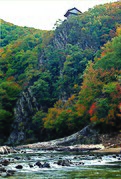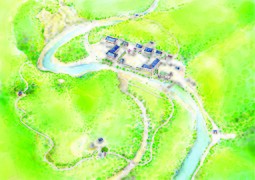269:
242:
260:
251:
36:
199:
Banyasa Temple's only designated heritage, the Three-Story Stone Pagoda (Treasure No. 1371), was relocated in 1950 from the so-called “Tapbeol,” situated in the
Seokcheon Valley north of Banyasa Temple. Thus, the pagoda doesn't provide any reliable information about the temple's history. In addition,
190:
The name “Banyasa” originated from a plaque King Sejo wrote when he attended the inauguration ceremony for the temple's reconstruction. Banyasa Temple was scheduled to open when King Sejo came to see Ven. Sinmi Daesa at
Bokcheonam Hermitage on Mt. Songnisan. King Sejo healed his own skin problems at
186:
Banyasa is said to have been established in 720 by Ven. Wonhyo or by Ven. Sangwon, one of Uisang's ten major disciples, but there are no records to confirm this. Another story tells that
National Preceptor Ven. Muyeom was its founder; this story has a more concrete background as it says: “When Ven.
217:
Standing with one's back to the Main Buddha Hall, to the rear of the dormitory on one's right, lies a 300-meter long, natural scree-rockslide that forms the perfect outline of a crouching tiger about to leap. To attract more tourists
Yeongdong-gun County recently established a photo zone from where
213:
In front of
Banyasa Temple, Gusucheon Stream, fed by water from Mt. Baekhwasan, forms an S-shape, which some people see as a “taegeuk.” (symbol of great polarity or yin-yang). In the center of the stream rises a lotus bud-shaped piece of land, on which Banyasa Temple seems to lean. The temple's
218:
visitors can take good pictures with the tiger's outline clearly seen in the background. The tiger's image is, geomantically, in the right place in these remote mountains, part of the Baekdu-daegan, the 460-mile-long mountain range that runs north and south the length of the Korean
Peninsula.
187:
Muyeom resided at
Simmyosa Temple in Hwanggan, he dispatched a novice monk named Ven. Sunin to the temple site to cast out the evil dragon living in the pond. Ven. Sunin then established Banyasa Temple after filling in the pond.”
191:
Banyasa Temple, as he did at
Sangwonsa Temple on Mt. Odaesan, thanks to the blessing of the child Manjusri. Afterward, he named the temple Banya (般若; perfection of wisdom), and even wrote its plaque, which is still preserved.
200:
the Buddha triad enshrined in the Main Buddha Hall, and the two monk's stupas are designated
Regional Cultural Heritage of Yeongdong-gun No. 9, No. 10, No. 11 and No. 12, in that order.
319:
214:
Munsujeon Hall perches atop a 100-meter-high cliff that overlooks the stream. The Hall reminds visitors they are in the sanctuary of
Manjusri Bodhisattva.
51:
324:
268:
241:
99:
92:
289:
304:
259:
250:
35:
140:
72:
313:
227:
175:
171:
167:
56:
114:
101:
71:
652 Baekhwasan-ro Hwanggan-myeon Yeongdong-gun North Chungcheong Province (
160:
163:
150:
230:
programs where visitors can experience Buddhist culture.
91:
83:
67:
62:
50:
45:
21:
8:
154:
144:
34:
18:
282:
237:
7:
305:Banyasa official website(in English)
320:Buddhist temples of the Jogye Order
209:Taegeuk-Shaped Terrain and a Tiger
14:
267:
258:
249:
240:
325:Buddhist temples in South Korea
159:, Pronounced “Ba-nya-sa”) is a
49:
155:
145:
16:Buddhist temple in South Korea
1:
40:Banyasa Temple in South Korea
290:Banyasa Temple stay program
341:
130:
76:
33:
26:
115:35.280694°N 127.909361°E
93:Geographic coordinates
120:35.280694; 127.909361
77:충청북도 영동군 황간면 백화산로 652
204:Cultural properties
111: /
134:
133:
332:
292:
287:
271:
262:
253:
244:
158:
157:
148:
147:
126:
125:
123:
122:
121:
116:
112:
109:
108:
107:
104:
78:
38:
19:
340:
339:
335:
334:
333:
331:
330:
329:
310:
309:
301:
296:
295:
288:
284:
279:
272:
263:
254:
245:
236:
226:It also offers
224:
206:
197:
184:
119:
117:
113:
110:
105:
102:
100:
98:
97:
41:
29:
17:
12:
11:
5:
338:
336:
328:
327:
322:
312:
311:
308:
307:
300:
299:External links
297:
294:
293:
281:
280:
278:
275:
274:
273:
266:
264:
257:
255:
248:
246:
239:
235:
232:
223:
220:
205:
202:
196:
193:
183:
180:
132:
131:
128:
127:
95:
89:
88:
85:
81:
80:
69:
65:
64:
60:
59:
54:
48:
47:
43:
42:
39:
31:
30:
27:
24:
23:
15:
13:
10:
9:
6:
4:
3:
2:
337:
326:
323:
321:
318:
317:
315:
306:
303:
302:
298:
291:
286:
283:
276:
270:
265:
261:
256:
252:
247:
243:
238:
233:
231:
229:
221:
219:
215:
211:
210:
203:
201:
194:
192:
188:
181:
179:
177:
173:
169:
165:
162:
152:
142:
138:
129:
124:
106:127°54′33.7″E
96:
94:
90:
86:
82:
74:
70:
66:
61:
58:
55:
53:
44:
37:
32:
25:
20:
285:
225:
216:
212:
208:
207:
198:
189:
185:
136:
135:
103:35°16′50.5″N
228:temple stay
176:South Korea
172:Chungcheong
168:Jogye Order
153::
143::
118: /
87:South Korea
57:Jogye Order
52:Affiliation
314:Categories
277:References
195:Landscape
161:Buddhist
68:Location
63:Location
46:Religion
234:Gallery
222:Tourism
182:History
166:of the
137:Banyasa
84:Country
22:Banyasa
164:temple
149:;
141:Korean
73:Korean
151:Hanja
170:in
156:般若寺
146:반야사
28:반야사
316::
178:.
174:,
75::
139:(
79:)
Text is available under the Creative Commons Attribution-ShareAlike License. Additional terms may apply.




